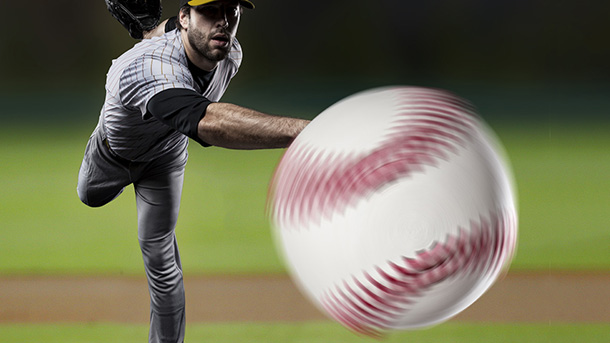Baseball fans are likely familiar with the phrase “Tommy John surgery.” While pitching for the Los Angeles Dodgers in the 1970s, John underwent the first surgery of its kind to repair damage to his elbow. The technical name for the procedure is ulnar collateral ligament reconstruction (UCL) surgery.
UCL injury has been occurring more frequently in college baseball athletes, especially pitchers, in the past decade, and USC physical therapy researcher Lori Michener, PhD, PT, is hoping to one day prevent it altogether. She recently received a PAC-12 Student-Athlete Health and Well-Being Grant to study UCL injury risk.
“The UCL is the ligament on the inside of your elbow that helps to stabilize the inside of your elbow joint,” explained Michener, a professor in the USC Division of Biokinesiology and Physical Therapy. “Elbow torque (rotational force) occurs during pitching. The higher that torque goes, the more pressure it will put on that elbow ligament. If there’s too much pressure on the UCL, it will can tear.”
The injuries are happening more often, most likely because pitchers are constantly striving to throw faster. But why do they occur in some pitchers and not others? That’s one of the issues Michener and her team will investigate in their study.
“We think it’s because of the factors being used to create ball velocity, which are strength and control of the legs through the trunk, through the shoulder and to the hand,” she said. “We’re trying to understand how physical factors — a pitcher’s strength, range of motion and ability to control his motion — can mediate that force on the elbow.”
Participating in the study are 150 pitchers from three universities, including USC, the University of Oregon and the University of California, Los Angeles.
Michener and her team will be running these pitchers through a battery of tests, including measuring the amount of torque at their elbow when they throw a baseball, the strength and control of their core and legs, shoulder range of motion and how well they can sense the position of their joints.
“The hypothesis is that players who have a lower elbow force while they’re pitching and a set ball velocity compared to the pitchers who have a higher force at the same ball velocity will have better physical factors, (i.e. better strength, better ability to produce and use that strength, and better range of motion and position sense),” Michener said. “They’re able to mediate and control the force that goes to the elbow during throwing.
“You see this in younger kids when they’re throwing,” she added. “They try to use their shoulder and elbow to get the ball where they want it to go versus trying to use their entire body so it’s a fluid, low-force motion by the time it gets to the elbow and there’s less force imparted to the elbow.”
Michener hopes to identify the physical factors that have the best ability to keep elbow torque lower while retaining the same velocity. That will give college medical professionals the tools to develop exercises to address any deficits.
“For example, if the deficit is a reduction in strength and control of your trunk,” Michener said, “we would give them exercises that have been shown to improve those areas. Our long-term goal is to prevent these UCL injuries.”
— Michelle McCarthy


